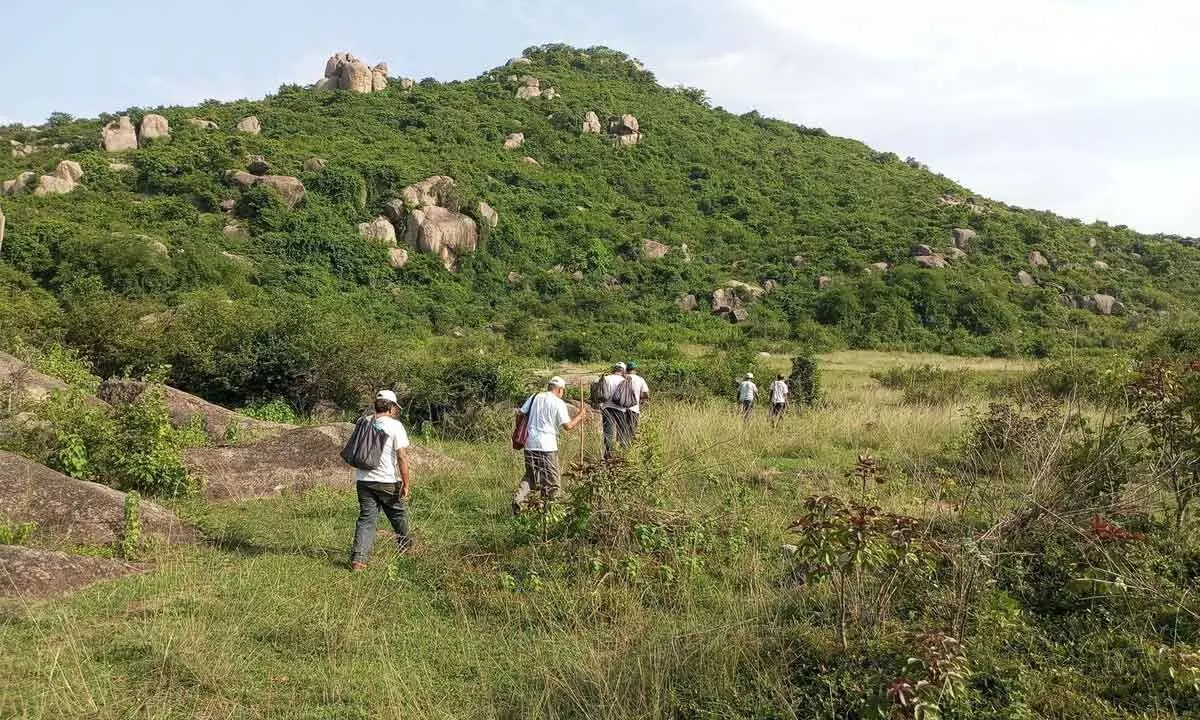Live
- BJP expresses condolence over death of 6 devotees
- Arrangements reviewed for Kotappakonda Tiranalu
- Pvt contractors protest over unpaid bills at GHMC
- Young skating prodigy sets sights on Asian Championship
- TG govt to pay salaries to all GP staff every month
- AIS women officers to inspect state-run girls resi. schools
- Free plastic surgery camp from January 17-30
- GHSPCA volunteers to rescue birds injured by Chinese manja
- Sankranti curbs: No kite-flying on roads, no DJ music playing in city
- Tirupati stampede is tragic says Dr Kota Neelima
Just In
‘Greenman’ completes green cover on 7 more bald hills in Ganjam


Berhampur: ‘Greenman of Odisha’ Sudhir Raut and his team of Aryabhatta E & N Foundation, Berhampur ended the two-month-old annual process for green...
Berhampur: ‘Greenman of Odisha’ Sudhir Raut and his team of Aryabhatta E & N Foundation, Berhampur ended the two-month-old annual process for green cover on seven bald hills in Ganjam during the rainy season this year on August 15.
The foundation, which already nourished 13 bald hills earlier, has taken up seven bald hills this year. The process of sowing seeds through seed balls dispersed in inaccessible areas of the hills and seeds sown on hoeing started on June 16 and ended on August 15. “We began seed ball preparation from May 1 by our seed ball machine. Some environment activists in Amar Kantak area, who have been working to bring greenery in Tapti and basin, gifted us a seed ball machine in 2019”, said Sudhir.
Some potting soil, clay mixed with manures and seeds are put into the machine. The soil rolls into balls picking up a few seeds. The balls are dried up. Each ball on an average contains 4 to 5 seeds. They are thrown from vintage positions on a hill. The seeds can remain safe inside the ball for two to three months. The seed ball protects the seeds from animals and birds. Rain breaks down the clay and the humus provides necessary nutrients for the young seedlings.
In the absence of human and cattle movements, the efficiency is up to 60 per cent. Even in their presence, 10 per cent survive. The saplings grown are stronger than those grown in nurseries and can also grow in adverse conditions, said Sudhir. Seed balls are an ancient technique for propagating plants from seeds without opening up soil with cultivation tools such as a plow.
The 13 bald hills in Ganjam, taken up from 2017 to 2022, include Balakumari, Podapadar, Bhaludhimbirai, Mahurikalua, Bhuasuni, Changudidei, Pakidi, Karakhola near Hinjilicut, Tara Tarini, Sahaspur and Bhaliagada Hill near Adapada.
Some of the hills such as Ramachandrapalli, Bhuasuni and Pakidi have shown good results with Ramchandrapalli being the best with around 50,000 trees. Balakumari, where mostly bamboo was used, has also shown good results. “The reforestation of these 13 bald hills was completed in 2019 and we intensively focussed on these hills for another three years,” said Sudhir.
The seven bald hills in Ganjam taken up this year include Rishidilli, Khola and Ramaguda Hills in Chikiti block and Dankari, Sana Buruda, Bada Buruda and Chadheigarda Hills under Sanakhemundi, Kukudakhandi and Digapahandi blocks.“We have scattered more than 2 lakh seed balls and sowed 15 lakh seeds this year. We sowed 13 lakh seeds on 13 bald hills taken up earlier and 2 lakh seeds on the new seven bald hills this year. Out of 60 days, we ventured intensively to reforest the bald and semi-bald hills for 42 consecutive days and another 10 days at some interval,” said Sudhir.
Interestingly, ‘Greenman of Odisha’ Sudhir Raut started green cover of bald hills from Rangamatia hill at Ramchandrapalli in Chikiti block in 2017 which was bald and barren and was rejected by the Forest department as degraded soil. Now, it is almost covered with greenery and has become a safe abode for wild animals.
To a question whether the rainfall is sufficient this year for the programme of reforestation of bald hills, Sudhir said it is adequate. Sudhir and his green team, who also supervise the aftermath of scattering seed balls and sowing seeds, said though 80 per cent seeds germinate, only 30 to 40 per cent survive to grow as a big tree. Some portions of the trees are eaten away by goats and cows and destroyed by the loggers, he said. ”When we sensitised the villagers to the plantation and reforestation, they helped us wholeheartedly,” said Sudhir.

© 2025 Hyderabad Media House Limited/The Hans India. All rights reserved. Powered by hocalwire.com






